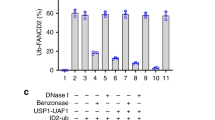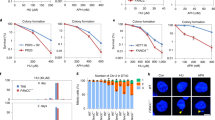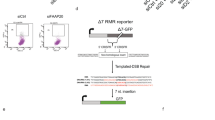Abstract
Fanconi D2 (FANCD2) is monoubiquitinated on K561 (FANCD2-Ub) in response to DNA double-strand breaks (DSBs) to stimulate repair of these potentially lethal DNA lesions. FANCD2-Ub was upregulated in CD34+ chronic myeloid leukemia (CML) cells and in BCR-ABL1 kinase-positive cell lines in response to elevated levels of reactive oxygen species (ROS) and DNA cross-linking agent mitomycin C. Downregulation of FANCD2 and inhibition of FANCD2-Ub reduced the clonogenic potential of CD34+ CML cells and delayed BCR-ABL1 leukemogenesis in mice. Retarded proliferation of BCR-ABL1 positive FANCD2−/− leukemia cells could be rescued by FANCD2 expression. BCR-ABL1 positive FANCD2−/− cells accumulated more ROS-induced DSBs in comparison with BCR-ABL1 positive FANCD2+/+ cells. Antioxidants diminished the number of DSBs and enhanced proliferation of BCR-ABL1 positive FANCD2−/− cells. Expression of wild-type FANCD2 and FANCD2(S222A) phosphorylation-defective mutant (deficient in stimulation of intra-S phase checkpoint, but proficient in DSB repair), but not FANCD2(K561R) monoubiquitination-defective mutant (proficient in stimulation of intra-S phase checkpoint, but deficient in DSB repair) reduced the number of DSBs and facilitated proliferation of BCR-ABL1 positive FANCD2−/− cells. We hypothesize that FANCD2-Ub has an important role in BCR-ABL1 leukemogenesis because of its ability to facilitate the repair of numerous ROS-induced DSBs.
This is a preview of subscription content, access via your institution
Access options
Subscribe to this journal
Receive 12 print issues and online access
$259.00 per year
only $21.58 per issue
Buy this article
- Purchase on Springer Link
- Instant access to full article PDF
Prices may be subject to local taxes which are calculated during checkout





Similar content being viewed by others
Accession codes
References
Jones D, Luthra R, Cortes J, Thomas D, O'Brien S, Bueso-Ramos C et al. BCR-ABL fusion transcript types and levels and their interaction with secondary genetic changes in determining the phenotype of Philadelphia chromosome-positive leukemias. Blood 2008; 112: 5190–5192.
Cramer K, Nieborowska-Skorska M, Koptyra M, Slupianek A, Penserga ET, Eaves CJ et al. BCR/ABL and other kinases from chronic myeloproliferative disorders stimulate single-strand annealing, an unfaithful DNA double-strand break repair. Cancer Res 2008; 68: 6884–6888.
Koptyra M, Falinski R, Nowicki MO, Stoklosa T, Majsterek I, Nieborowska-Skorska M et al. BCR/ABL kinase induces self-mutagenesis via reactive oxygen species to encode imatinib resistance. Blood 2006; 108: 319–327.
Nowicki MO, Falinski R, Koptyra M, Slupianek A, Stoklosa T, Gloc E et al. BCR/ABL oncogenic kinase promotes unfaithful repair of the reactive oxygen species-dependent DNA double-strand breaks. Blood 2004; 104: 3746–3753.
Klemm L, Duy C, Iacobucci I, Kuchen S, von Levetzow G, Feldhahn N et al. The B cell mutator AID promotes B lymphoid blast crisis and drug resistance in chronic myeloid leukemia. Cancer Cell 2009; 16: 232–245.
Feldhahn N, Henke N, Melchior K, Duy C, Soh BN, Klein F et al. Activation-induced cytidine deaminase acts as a mutator in BCR-ABL1-transformed acute lymphoblastic leukemia cells. J Exp Med 2007; 204: 1157–1166.
Radfar A, Unnikrishnan I, Lee HW, DePinho RA, Rosenberg N . p19(Arf) induces p53-dependent apoptosis during abelson virus-mediated pre-B cell transformation. Proc Natl Acad Sci USA 1998; 95: 13194–13199.
Wang PY, Young F, Chen CY, Stevens BM, Neering SJ, Rossi RM et al. The biologic properties of leukemias arising from BCR/ABL-mediated transformation vary as a function of developmental origin and activity of the p19ARF gene. Blood 2008; 112: 4184–4192.
Slupianek A, Nowicki MO, Koptyra M, Skorski T . BCR/ABL modifies the kinetics and fidelity of DNA double-strand breaks repair in hematopoietic cells. DNA Repair (Amst) 2006; 5: 243–250.
Fernandes MS, Reddy MM, Gonneville JR, DeRoo SC, Podar K, Griffin JD et al. BCR-ABL promotes the frequency of mutagenic single-strand annealing DNA repair. Blood 2009; 114: 1813–1819.
Brady N, Gaymes TJ, Cheung M, Mufti GJ, Rassool FV . Increased error-prone NHEJ activity in myeloid leukemias is associated with DNA damage at sites that recruit key nonhomologous end-joining proteins. Cancer Res 2003; 63: 1798–1805.
Nakanishi K, Yang YG, Pierce AJ, Taniguchi T, Digweed M, D'Andrea AD et al. Human Fanconi anemia monoubiquitination pathway promotes homologous DNA repair. Proc Natl Acad Sci USA 2005; 102: 1110–1115.
Adamo A, Collis SJ, Adelman CA, Silva N, Horejsi Z, Ward JD et al. Preventing nonhomologous end joining suppresses DNA repair defects of Fanconi anemia. Mol Cell 2010; 39: 25–35.
Lundberg R, Mavinakere M, Campbell C . Deficient DNA end joining activity in extracts from fanconi anemia fibroblasts. J Biol Chem 2001; 276: 9543–9549.
D'Andrea AD, Grompe M . The Fanconi anaemia/BRCA pathway. Nat Rev Cancer 2003; 3: 23–34.
Moldovan GL, D'Andrea AD . How the fanconi anemia pathway guards the genome. Annu Rev Genet 2009; 43: 223–249.
Garcia-Higuera I, Taniguchi T, Ganesan S, Meyn MS, Timmers C, Hejna J et al. Interaction of the Fanconi anemia proteins and BRCA1 in a common pathway. Mol Cell 2001; 7: 249–262.
Taniguchi T, Garcia-Higuera I, Xu B, Andreassen PR, Gregory RC, Kim ST et al. Convergence of the fanconi anemia and ataxia telangiectasia signaling pathways. Cell 2002; 109: 459–472.
Smogorzewska A, Matsuoka S, Vinciguerra P, McDonald III ER, Hurov KE, Luo J et al. Identification of the FANCI protein, a monoubiquitinated FANCD2 paralog required for DNA repair. Cell 2007; 129: 289–301.
Ishiai M, Kitao H, Smogorzewska A, Tomida J, Kinomura A, Uchida E et al. FANCI phosphorylation functions as a molecular switch to turn on the Fanconi anemia pathway. Nat Struct Mol Biol 2008; 15: 1138–1146.
Rothfuss A, Grompe M . Repair kinetics of genomic interstrand DNA cross-links: evidence for DNA double-strand break-dependent activation of the Fanconi anemia/BRCA pathway. Mol Cell Biol 2004; 24: 123–134.
Alpi AF, Patel KJ . Monoubiquitylation in the Fanconi anemia DNA damage response pathway. DNA Repair (Amst) 2009; 8: 430–435.
Alter BP . Cancer in Fanconi anemia, 1927–2001. Cancer 2003; 97: 425–440.
Kutler DI, Singh B, Satagopan J, Batish SD, Berwick M, Giampietro PF et al. A 20-year perspective on the International Fanconi Anemia Registry (IFAR). Blood 2003; 101: 1249–1256.
Rosenberg PS, Greene MH, Alter BP . Cancer incidence in persons with Fanconi anemia. Blood 2003; 101: 822–826.
Garcia-Higuera I, Taniguchi T, Ganesan S, Meyn MS, Timmers C, Hejna J et al. Interaction of the Fanconi anemia proteins and BRCA1 in a common pathway. Mol Cell 2001; 7: 249–262.
Rink L, Slupianek A, Stoklosa T, Nieborowska-Skorska M, Urbanska K, Seferynska I et al. Enhanced phosphorylation of Nbs1, a member of DNA repair/checkpoint complex Mre11-RAD50-Nbs1, can be targeted to increase the efficacy of imatinib mesylate against BCR/ABL-positive leukemia cells. Blood 2007; 110: 651–660.
Houghtaling S, Timmers C, Noll M, Finegold MJ, Jones SN, Meyn MS et al. Epithelial cancer in Fanconi anemia complementation group D2 (Fancd2) knockout mice. Genes Dev 2003; 17: 2021–2035.
Skorski T, Bellacosa A, Nieborowska-Skorska M, Majewski M, Martinez R, Choi JK et al. Transformation of hematopoietic cells by BCR/ABL requires activation of a PI-3k/Akt-dependent pathway. Embo J 1997; 16: 6151–6161.
Pear WS, Miller JP, Xu L, Pui JC, Soffer B, Quackenbush RC et al. Efficient and rapid induction of a chronic myelogenous leukemia-like myeloproliferative disease in mice receiving P210 bcr/abl-transduced bone marrow. Blood 1998; 92: 3780–3792.
Taniguchi T, Garcia-Higuera I, Xu B, Andreassen PR, Gregory RC, Kim ST et al. Convergence of the fanconi anemia and ataxia telangiectasia signaling pathways. Cell 2002; 109: 459–472.
Canitrot Y, Falinski R, Louat T, Laurent G, Cazaux C, Hoffmann JS et al. p210 BCR/ABL kinase regulates nucleotide excision repair (NER) and resistance to UV radiation. Blood 2003; 102: 2632–2637.
Singh NP, McCoy MT, Tice RR, Schneider EL . A simple technique for quantitation of low levels of DNA damage in individual cells. Exp Cell Res 1988; 175: 184–191.
Majsterek I, Blasiak J, Mlynarski W, Hoser G, Skorski T . Does the bcr/abl-mediated increase in the efficacy of DNA repair play a role in the drug resistance of cancer cells? Cell Biol Int 2002; 26: 363–370.
Montes de Oca R, Andreassen PR, Margossian SP, Gregory RC, Taniguchi T, Wang X et al. Regulated interaction of the Fanconi anemia protein, FANCD2, with chromatin. Blood 2005; 105: 1003–1009.
Landais I, Sobeck A, Stone S, LaChapelle A, Hoatlin ME . A novel cell-free screen identifies a potent inhibitor of the Fanconi anemia pathway. Int J Cancer 2009; 124: 783–792.
Slupianek A, Schmutte C, Tombline G, Nieborowska-Skorska M, Hoser G, Nowicki MO et al. BCR/ABL regulates mammalian RecA homologs, resulting in drug resistance. Mol Cell 2001; 8: 795–806.
Finkel T . Oxidant signals and oxidative stress. Curr Opin Cell Biol 2003; 15: 247–254.
Martindale JL, Holbrook NJ . Cellular response to oxidative stress: signaling for suicide and survival. J Cell Physiol 2002; 192: 1–15.
Wajapeyee N, Wang SZ, Serra RW, Solomon PD, Nagarajan A, Zhu X et al. Senescence induction in human fibroblasts and hematopoietic progenitors by leukemogenic fusion proteins. Blood 2010; 115: 5057–5060.
Zhang QS, Marquez-Loza L, Eaton L, Duncan AW, Goldman DC, Anur P et al. Fancd2−/− mice have hematopoietic defects that can be partially corrected by resveratrol. Blood 2010; 116: 5140–5148.
Pang Q, Andreassen PR . Fanconi anemia proteins and endogenous stresses. Mutat Res 2009; 668: 42–53.
Futaki M, Igarashi T, Watanabe S, Kajigaya S, Tatsuguchi A, Wang J et al. The FANCG Fanconi anemia protein interacts with CYP2E1: possible role in protection against oxidative DNA damage. Carcinogenesis 2002; 23: 67–72.
Park SJ, Ciccone SL, Beck BD, Hwang B, Freie B, Clapp DW et al. Oxidative stress/damage induces multimerization and interaction of Fanconi anemia proteins. J Biol Chem 2004; 279: 30053–30059.
Valeri A, Alonso-Ferrero ME, Rio P, Pujol MR, Casado JA, Perez L et al. Bcr/Abl interferes with the Fanconi anemia/BRCA pathway: implications in the chromosomal instability of chronic myeloid leukemia cells. PLoS One 2010; 5: e15525.
Nieborowska-Skorska M, Stoklosa T, Datta M, Czechowska A, Rink L, Slupianek A et al. ATR-Chk1 axis protects BCR/ABL leukemia cells from the lethal effect of DNA double-strand breaks. Cell Cycle 2006; 5: 994–1000.
Vinciguerra P, Godinho SA, Parmar K, Pellman D, D'Andrea AD . Cytokinesis failure occurs in Fanconi anemia pathway-deficient murine and human bone marrow hematopoietic cells. J Clin Invest 2010; 120: 3834–3842.
Howlett NG, Taniguchi T, Durkin SG, D'Andrea AD, Glover TW . The Fanconi anemia pathway is required for the DNA replication stress response and for the regulation of common fragile site stability. Hum Mol Genet 2005; 14: 693–701.
Keller G, Brassat U, Braig M, Heim D, Wege H, Brummendorf TH . Telomeres and telomerase in chronic myeloid leukaemia: impact for pathogenesis, disease progression and targeted therapy. Hematol Oncol 2009; 27: 123–129.
Callen E, Samper E, Ramirez MJ, Creus A, Marcos R, Ortega JJ et al. Breaks at telomeres and TRF2-independent end fusions in Fanconi anemia. Hum Mol Genet 2002; 11: 439–444.
Li J, Du W, Maynard S, Andreassen PR, Pang Q . Oxidative stress-specific interaction between FANCD2 and FOXO3a. Blood 1545; 115: 1545–1548.
Ghaffari S, Jagani Z, Kitidis C, Lodish HF, Khosravi-Far R . Cytokines and BCR-ABL mediate suppression of TRAIL-induced apoptosis through inhibition of forkhead FOXO3a transcription factor. Proc Natl Acad Sci USA 2003; 100: 6523–6528.
Ikeda H, Matsushita M, Waisfisz Q, Kinoshita A, Oostra AB, Nieuwint AW et al. Genetic reversion in an acute myelogenous leukemia cell line from a Fanconi anemia patient with biallelic mutations in BRCA2. Cancer Res 2003; 63: 2688–2694.
Acknowledgements
We thank Dr Alan D D'Andrea (Dana-Farber Cancer Institute, Boston, MA, USA) for providing FANCD2 expression plasmids and FANCD2 cell lines, and Dr Marcus Grompe (Oregon Health and Science University, Portland, OR, USA) for the knockout mice. We also thank Elisabeth Bolton for careful reading of the manuscript. This study was supported by NIH/NCI CA89052 and CA123014 (T Skorski), by 1M19/NK1W/2009 and 1M19/NK1D/2009 from Medical University of Warsaw (T Stoklosa and E Glodkowska-Mrowka) and by N N401 039037 from Polish Ministry of Education and Science (G Hoser). T Stoklosa was the recipient of YY 2009 fellowship from International Union Against Cancer. We thank E Bolton for critical reading of the manuscript and K Piwocka and M Kucia-Kobialko for their help with nucleofection.
Author information
Authors and Affiliations
Corresponding author
Ethics declarations
Competing interests
The authors declare no conflict of interest.
Additional information
Supplementary Information accompanies the paper on the Leukemia website
Rights and permissions
About this article
Cite this article
Koptyra, M., Stoklosa, T., Hoser, G. et al. Monoubiquitinated Fanconi anemia D2 (FANCD2-Ub) is required for BCR-ABL1 kinase-induced leukemogenesis. Leukemia 25, 1259–1267 (2011). https://doi.org/10.1038/leu.2011.91
Received:
Revised:
Accepted:
Published:
Issue Date:
DOI: https://doi.org/10.1038/leu.2011.91
Keywords
This article is cited by
-
Whole exome sequencing reveals concomitant mutations of multiple FA genes in individual Fanconi anemia patients
BMC Medical Genomics (2014)
-
While at Rome miRNA and TRAIL Do Whatever BCR-ABL Commands to Do
Archivum Immunologiae et Therapiae Experimentalis (2013)
-
Unraveling the role of FANCD2 in chronic myeloid leukemia
Leukemia (2012)



